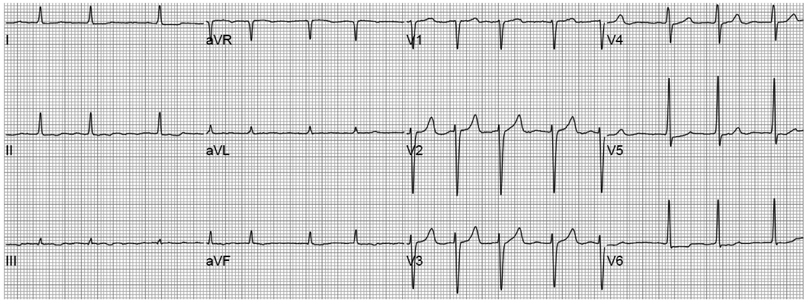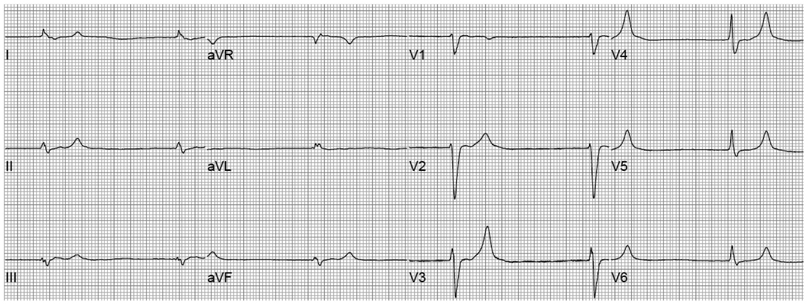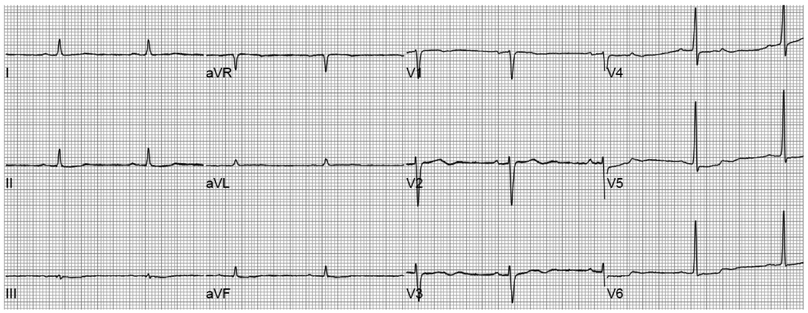Korean Circ J.
2012 Jan;42(1):65-68. 10.4070/kcj.2012.42.1.65.
Spontaneous Sinus Conversion of Permanent Atrial Fibrillation During Treatment of Hyperkalemia
- Affiliations
-
- 1Cardiology Division, Department of Internal Medicine, Yonsei University College of Medicine, Seoul, Korea. sejoong@yuhs.ac
- KMID: 2297912
- DOI: http://doi.org/10.4070/kcj.2012.42.1.65
Abstract
- Hyperkalemia is a common adverse effect of treatment for heart failure and is associated with high mortality and morbidity. The cardiac manifestations of hyperkalemia include various electrocardiogram changes. We describe a case of a 74-year-old woman with heart failure and permanent atrial fibrillation who reverted to normal sinus rhythm during recovery from hyperkalemia.
Figure
Reference
-
1. Nyirenda MJ, Tang JI, Padfield PL, Seckl JR. Hyperkalaemia. BMJ. 2009. 339:b4114. doi: 10.1136/bmj.b4114.2. Paice B, Gray JM, McBride D, Donnelly T, Lawson DH. Hyperkalaemia in patients in hospital. Br Med J (Clin Res Ed). 1983. 286:1189–1192.3. Moore ML, Bailey RR. Hyperkalaemia in patients in hospital. N Z Med J. 1989. 102:557–558.4. Shemer J, Modan M, Ezra D, Cabili S. Incidence of hyperkalemia in hospitalized patients. Isr J Med Sci. 1983. 19:659–661.5. Evans KJ, Greenberg A. Hyperkalemia: a review. J Intensive Care Med. 2005. 20:272–290.6. Juurlink DN, Mamdani MM, Lee DS, et al. Rates of hyperkalemia after publication of the Randomized Aldactone Evaluation Study. N Engl J Med. 2004. 351:543–551.7. Diercks DB, Shumaik GM, Harrigan RA, Brady WJ, Chan TC. Electrocardiographic manifestations: electrolyte abnormalities. J Emerg Med. 2004. 27:153–160.8. Webster A, Brady W, Morris F. Recognising signs of danger: ECG changes resulting from an abnormal serum potassium concentration. Emerg Med J. 2002. 19:74–77.9. Kahloon MU, Aslam AK, Aslam AF, Wilbur SL, Vasavada BC, Khan IA. Hyperkalemia induced failure of atrial and ventricular pacemaker capture. Int J Cardiol. 2005. 105:224–226.10. Schiraldi F, Guiotto G, Paladino F. Hyperkalemia induced failure of pacemaker capture and sensing. Resuscitation. 2008. 79:161–164.11. Romeo E, D'alto M, Santarpia G, et al. Hyperkalemia-induced conversion of permanent atrial fibrillation to normal sinus rhythm: a case report. J Cardiovasc Med (Hagerstown). 2011. 12:678–680.12. Gogas BD, Iliodromitis EK, Leftheriotis DI, Flevari PG, Rallidis LS, Kremastinos DT. Instantaneous electrocardiographic changes and transient sinus rhythm restoration in severe hyperkalaemia. Int J Cardiol. 2011. 148:e40–e42.13. Mathew PK. Hyperkalemia-induced conversion of chronic atrial fibrillation to normal sinus rhythm: a case report. Angiology. 1979. 30:143–146.14. Fisch C, Knoebel SB, Feigenbaum H, Greenspan K. Potassium and the monophasic action potential, electrocardiogram, conduction and arrhythmias. Prog Cardiovasc Dis. 1966. 8:387–418.15. Camm AJ, Kirchhof P, Lip GY, et al. Guidelines for the management of atrial fibrillation: the Task Force for the Management of Atrial Fibrillation of the European Society of Cardiology (ESC). Europace. 2010. 12:1360–1420.16. Capucci A, Villani GQ, Aschieri D, Rosi A, Piepoli MF. Oral amiodarone increases the efficacy of direct-current cardioversion in restoration of sinus rhythm in patients with chronic atrial fibrillation. Eur Heart J. 2000. 21:66–73.17. Middlekauff HR, Wiener I, Stevenson WG. Low-dose amiodarone for atrial fibrillation. Am J Cardiol. 1993. 72:75F–81F.18. Gomes JA, Kang PS, Hariman RJ, El Sherif N, Lyons J. Electrophysiologic effects and mechanisms of termination of supraventricular tachycardia by intravenous amiodarone. Am Heart J. 1984. 107:214–221.19. Kamiya K, Nishiyama A, Yasui K, Hojo M, Sanguinetti MC, Kodama I. Short- and long-term effects of amiodarone on the two components of cardiac delayed rectifier K(+) current. Circulation. 2001. 103:1317–1324.20. Naccarelli GV, Lukas MA. Carvedilol's antiarrhythmic properties: therapeutic implications in patients with left ventricular dysfunction. Clin Cardiol. 2005. 28:165–173.
- Full Text Links
- Actions
-
Cited
- CITED
-
- Close
- Share
- Similar articles
-
- Electrophysiologic Characteristics in the Process of Conversion from Atrial Fibrillation to Atrial Flutter
- Spontaneous Conversion of Atrial Fibrillation to Normal Sinus Rhythm Following Recurrent Cerebral Infarctions
- A Totally Thoracoscopic Ablation for Persistent Atrial Fibrillation
- The Cox-Maze Procedure for Atrial Fibrillation not Associated with Mitral Valve Disease: Report of three cases
- Resolution of atrial fibrillation with induction of general anesthesia: A case report




